
|   |

|   |
 e-mail: leelakaverivenkat@gmail.com Swarna Saroja program proves an eye opener July 23, 2024 The second event of the ongoing Swarna Saroja programs at Ganesa Natyalaya as homage to the founder of the institution, the recently departed Dr.Saroja Vaidyanathan, had its surprises for the audience in the packed hall. The evening had two sections, Dharover (signifying tradition passing on from teacher to student from one generation to another) and Sabka Vikas (meaning progress for all). Starting under the Dharovar section, was a Bharatanatyam program Smaran, presented understandably (considering the occasion) by a student of Saroja Vaidyanathan, Anupa Thakurta settled in Atlanta, USA, where she runs the Deeksha School for Performing Arts. The evening proved how, despite the passage of time, the umbilical cord with Ganesa Natyalaya remained for many senior dancers who had been trained under Saroja Vaidyanathan. And here was an instance of a student, after twenty three years visiting the institution where she had started her Bharatanatyam journey. One knows that foreign tours of Rama Vaidyanathan (who inherits the teaching reins) with visits to Atlanta, have greatly helped in keeping the Natyalaya bonds alive. The performance began in the devotional vein with a Mulamantra, asking for protection against the Divine - Om Sacchidananda Parabrahma, Purushottama Paramatma set to adi talam in raga Hamsavinodini by Sudha Raghuraman. What struck one was the poise and group discipline of the dancers. The Alarippu by Ramamurthy Kesavan in Chatusra Ekam saw three dancers in fine control of stances and general dance profile. What is more, the movement choreography for the threesome by Anupa was artistically conceived. The abhinaya part had its presentation through a simple Surdas Pada Murali Nada Sunaye set to music by G.S. Rajan with dance composed by Rama Vaidyanathan. Rendered in solo form by Anupa herself, both grace and a sense of involvement characterized the rendition. The Salam Daruvu set to Nattai ragam and adi talam, in this case addressed to ruler Sarfoji Maharaj, is what came into South India's dance traditions like Kuchipudi in particular and Bharatanatyam too, with the Persian / Islamic influence of the Bahmani Kingdom in the South (1347-1527) founded by Allauddin Hasan Bahman Shah. The dancer group presenting this also proved meticulous training. In the entire program, the manner in which frozen sculpturesque moments portraying Trishoola Mardhini, Mahishasuramardhini, Simhavahini, Kamita Varadehi showing the Goddess in attitudes of power and authority were executed, spoke of well set, balanced dance bodies. 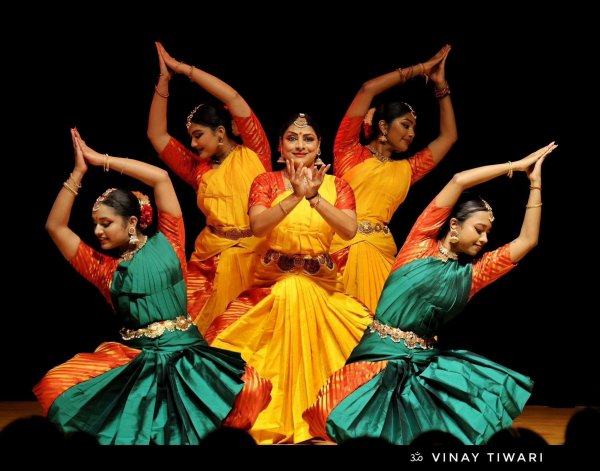 Anupa Thakurta and group Based on the lyrics and rhythm of Mohan Vaidya and Ramamurti Kesavan, Swaranjali in ragamalika and talamalika with dance visualization by Saroja Vaidyanathan, ushered in the finale. Announced as the piece de resistance of every program by this group, the present version with some changes by Anupa, was performed with the same disciplined nritta control by the group. With all the impeccable technical training, one would have liked stronger indications of abhinaya in the presentation. When asked about this, Anupa very frankly replied, "These children are raised in a society which is very different - and while they are very committed students, they cannot vibe well with the Margam abhinaya items of Padams and Javalis fashioned round the Nayika/Nayak interactions." That she preferred not to force on the students what they were not convinced about, was clear. Shows the challenges of finding lebensraum for art traditions transplanted to areas away from the cultural soil, in which they have been nurtured for generations! Accommodation has always been a factor with traditions in transition. UNSUNG TALENTS AWAY FROM THE GLITTERATI The second part of the evening was a strong pointer to talents existing in unknown quarters, away from the array of publicized performances one is treated to. Pertaining to the Sabka Vikas part, it brings us to the story of Aravindam Foundation initiated in 2009 - a brainchild of Dr. Lokesh Abrol, Consultant in Internal Medicine in Gurgaon. Functioning from an unpretentious shed erected in Palam Vihar of Gurgaon, with tiny sheds and spaces all round, this Foundation or 'Gurukul' as it is formally registered, imparts lessons to children from the least privileged sections of society in art disciplines, like Bharatanatyam, Kathak, Kalaripayattu and Hindustani classical music. Working at curing bodily ailments, Dr.Lokesh Abrol was fired by the urge to provide succor for mental and psychological drawbacks among children growing up amidst the harsh profile of impoverished living. "Our students, at present about 300 in number, are all offspring of maid servants, of masons, of daily wage earners, of drivers and so on. Growing up in slums and even on the bare streets, these youngsters have no idea of what Indian heritage means. Endowed with endless energy and an indomitable will, they lack the financial support for training in anything - leave alone art. But for the short time they are involved with these classes, they all seem to experience a kind of rejuvenating escape from the crushing contours of slum life - which is why they are continuing despite nobody forcing them to learn." "It has not been easy though, and it is getting to be more and more difficult to get parental acceptance for even the short spells the children enjoy here away from the daily grind. The girl students find it even more difficult, with a prevailing suspicion that the teenage child will be drawn into an infamous dancer's life with no promise of decent earnings." Totally in keeping with what Dr.Lokesh said, dancer Rama Vaidyanathan mentioned to me that even on the evening the children were to perform at the Ganesa Natyalaya, the parents of many of the youngsters had insisted that they earn their daily wages and hand them over to the family, before leaving for the performance. "I first fed them before they could rehearse for a short while to get a feel of the stage. Then they washed, got into their costumes and performed - after which of course dinner was served." Chained to the daily grind to just keep body and soul together, these parents are least concerned about education and arts for their kids. 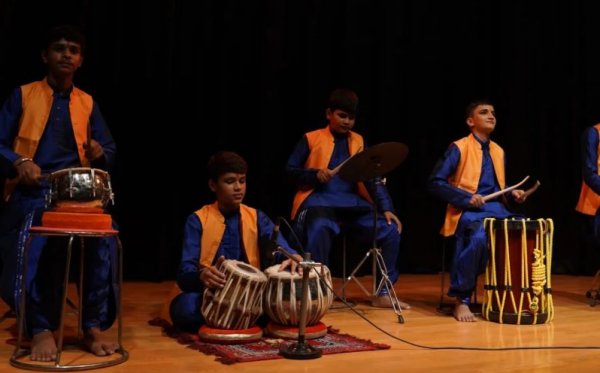 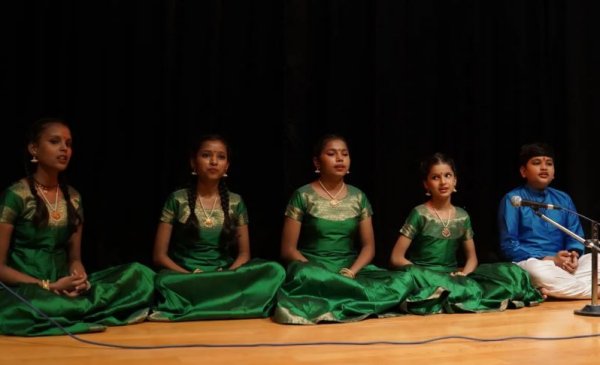 The voluntary teaching effort comes from some dedicated dancers like Vaishnavi Vitthal Dore, trained under Rama Vaidyanathan, Moumita Ghosh trained under late Birju Maharaj, Saswati and others. The trainer for Kalaripayattu is Ashish Kumar, and for Hindustani music teaching is Sumit Pandey 'Shivit' who has been trained in the Benares gharana. Classes in formal education too are imparted, otherwise, for these kids living in the slums, it is the law of the jungle that takes over. The evening dedicated to the Devi in She-the Divine, began with the dulcet strains of a short vocal alap in Darbari Kanada of the Mahakali Bhajan by Sumit Pandey Shivit who had himself composed the music for lyrics written by Dr.Abrol. What came as a pleasant surprise was the sur filled nectar in the singing by youngsters Kamna, Kajal, Naina, Hardik, Tanish, Jenika and Reyansh, which was wonderful to hear - considering that much of the music from the wings, even for professional dance concerts, one hears very indifferent singing. Under Shailendra Singh, the drum trainer, those learning to play percussion are Kajal, Miraj, Reyansh, Arun, Dharmendra, Hardik and Tanish. 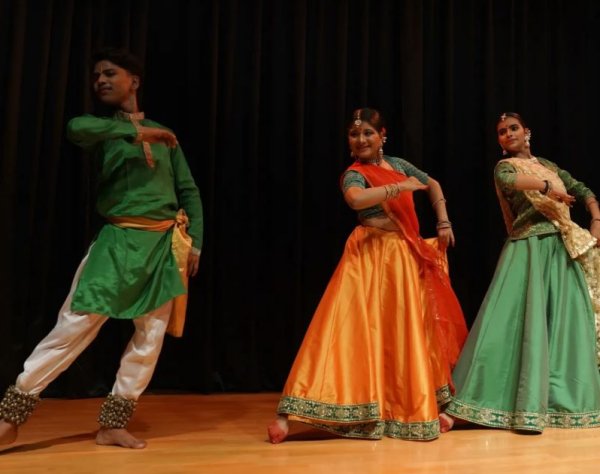
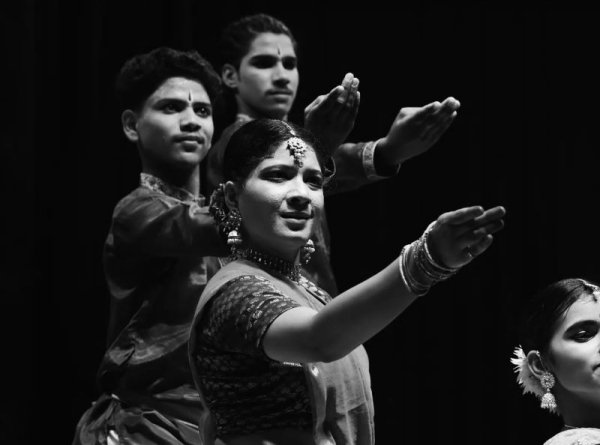
The Kathak rendered by dancers Salina, Amar, Miraj, Jyoti, all very neatly turned out, started with a Kavit in praise of the Devi Jaya Jaya Jaya Janani De , who by destroying asuras is the Suranaramuni savior. The clean 'Ang sanchallan' with footwork and neatly executed chakkars, (while the youngsters have still a long way to go before mastering more complicated improvised passages), pointed to diligent teaching and the dancers showed no stage reservation of any type. The next presentation was an Ashtakam in Bharatanatyam set to a Ragamalika - Namastestu Mahadevi Sreepeethe Surapoojite. The Goddess in various manifestations and qualities like Tsoola/Sookshma, Maharaudre, Bhukmukti pradayini, and Lakshmi as Naanaalakshara Bhooshite, particularly the sections set to ragas Mohanam and the concluding Madhyamavati, were brought out very effectively in the dance, and one was happily surprised by the exactitude of dance profile and well set movements of the dancers Sweety, Garima, Sonam, Manisha, Deepika, Meenakshi, Drishti, Neetu. It spoke highly of teacher Vaishnavi's work. From a similar background herself, her exceptional talents were discovered early by her teacher Rama Vaidyanathan who took her under her wings, and today she accompanies her on her foreign tours! She is presently also booked for a role in a Marathi film, and even a brief interaction with this poised person shows how far she has come in life. When Rama Vaidyanathan was approached by the Foundation for a teacher, she picked on Vaishnavi as one with a similar background would vibe well with the Gurukul children - and today Vaishnavi is its most committed teacher. She was the visualizer, who conceived the rounded program for this Swarna Saroja function. 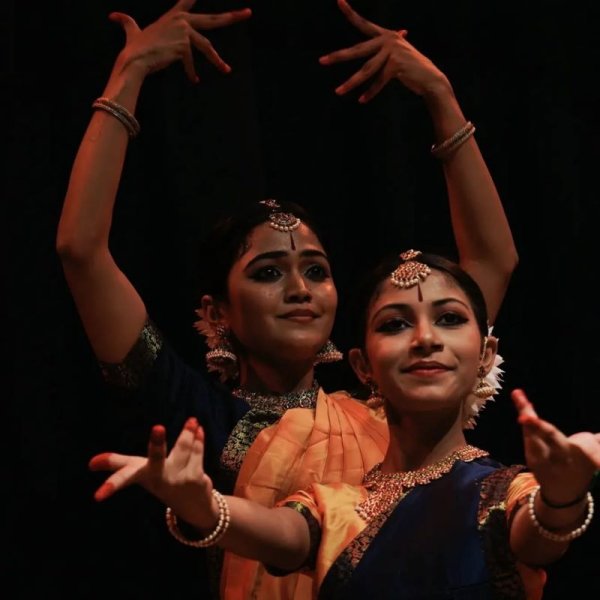
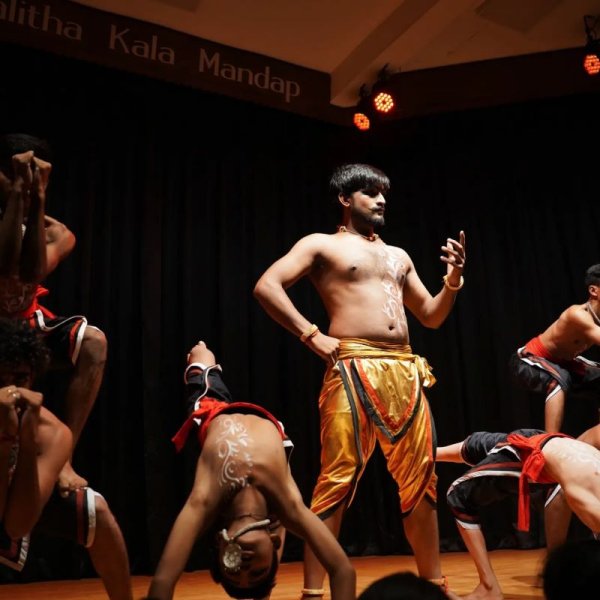
The Kalaripayattu boys, Himanshu, Sagar, Narendra, Nikesh, Anshu, Tanish, Raj, trimly turned out in the typical outfit, performed the exercises with light springy bodies. This again is a martial art which has to be taught with the right technique. The finale prayer Aigiri Nandini in this all Devi homage, visualized her as destroyer of the evil Mahisha. The entire cast came together, blending Rakshas Gan of Kalaripayattu, and Bharatanatyam and Kathak dancers doing the Gondhali Nritya type of folk rhythm of Maharashtra, for which the lyrics of Abrol had been set to music by Niranjan Pedgaonkar. The destruction of the demon by Khandoba carried the same message of the Goddess as the destroyer of evil. With the lusty drummers trained by Shailendra Singh, the percussion support to spread the message of victory was more than enough. Fired by this performance, my visit to the Gurukul gave me a chance to see the institution in action. A tiny room with shelves which is the 'library' with some books has two people working and nearby is the main shed where Kathak and Bharatanatyam dancers are taught. Another tiny space was where I was treated to the Hindustani music class. One could see how children of all ages - even the five year olds - were getting some kind of inner joy through singing. And it was wonderful to see how perfect the micro tonal alignment was as they took part in the singing. When I asked the kids why they took part in this class, they all expressed (the little ones without words but in their expressions) how participating in the music classes gave them a relaxed feel away from the grim realities of home. Through some donations and a lot of his own earnings, Dr.Lokesh Abrol has kept the Gurukul going. "This is government land. Perhaps because of the work being done here, no government official has bothered us." But he wants to set up the Gurukul with an assured minimal subsistence to keep it going. While some children show real talent which would be a shame not to develop just because of poverty, even those who may not make the grade for being future artists, are getting precious moments of joy - away from the realities of having to live from day to day in squalid conditions. Instead of being driven into extreme situations and even crime, if we want to create healthy minds in our children, the government and sections of society have to come forward to help such institutions flourish. Surely, the official bodies looking after art and culture like the SNA or even the Kathak Kendra must be having some schemes to help the very needy sections of society. Politicians keep intoning about destroying poverty and helping the lowest strata of society to move up. Government funds are a must for these children, who in the midst of squalor and a very hard life, are courageously pursuing art. For such earnest efforts where every pie will be used to better the lives of the economically down trodden, government land, building grants, basic salary grants for the teaching staff, and schemes for ensuring a more just life for young people are a must.  Writing on the dance scene for the last forty years, Leela Venkataraman's incisive comments on performances of all dance forms, participation in dance discussions both in India and abroad, and as a regular contributor to Hindu Friday Review, journals like Sruti and Nartanam, makes her voice respected for its balanced critiquing. She is the author of several books like Indian Classical dance: Tradition in Transition, Classical Dance in India and Indian Classical dance: The Renaissance and Beyond. Response * The story of Dr.Lokesh and his Aravindan Foundation is so touching and inspiring! A must read for all. - Shyamhari (July 25, 2024) Post your comments Pl provide your name and email id along with your comment. All appropriate comments posted with name and email id in the blog will also be featured in the site. |